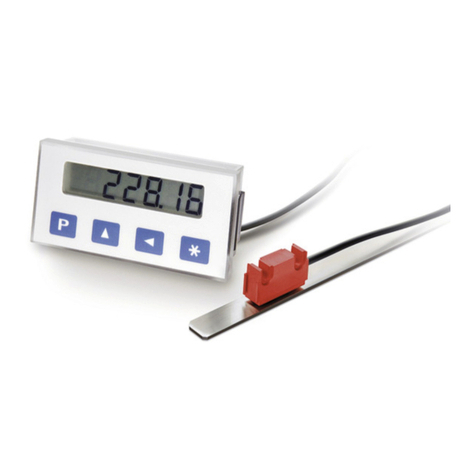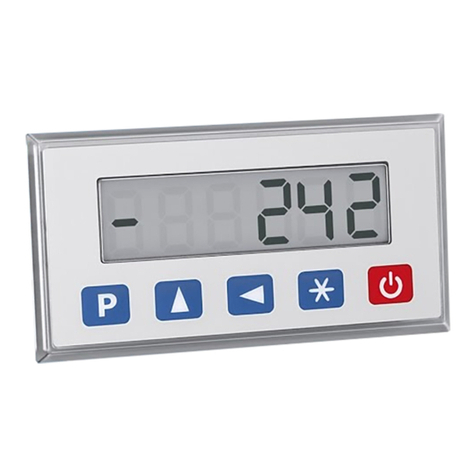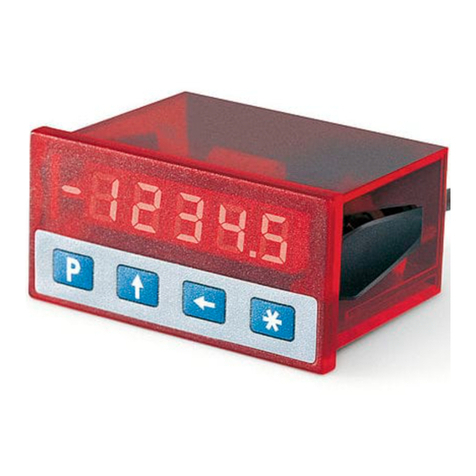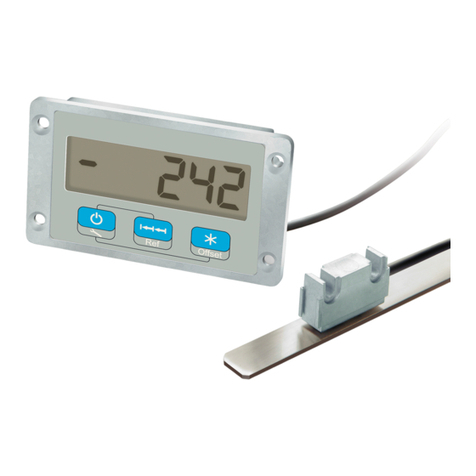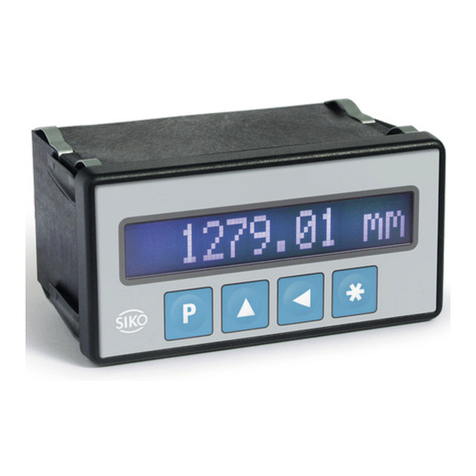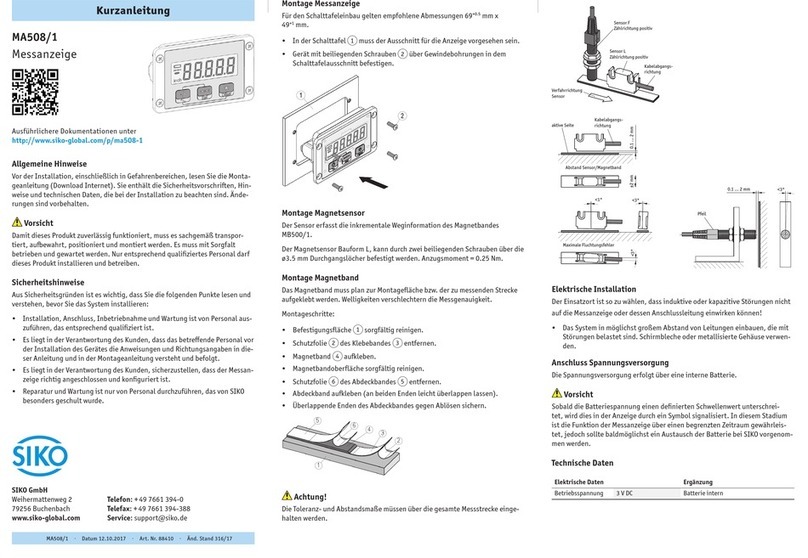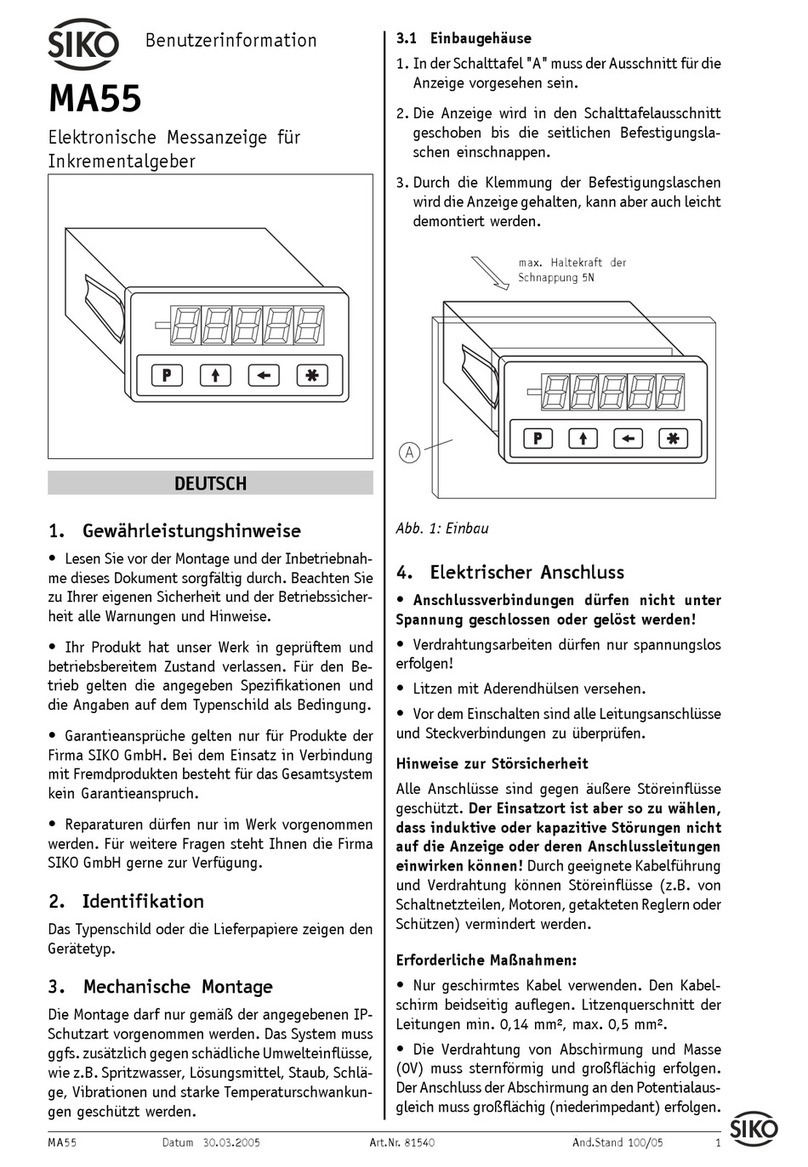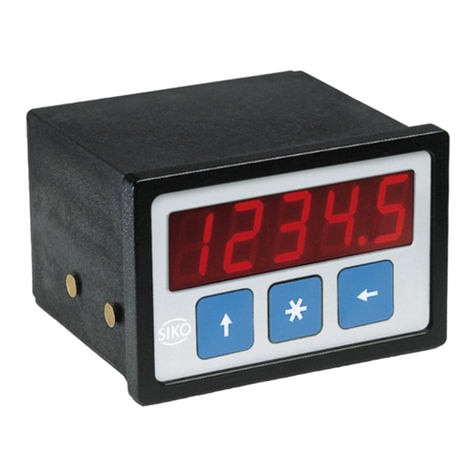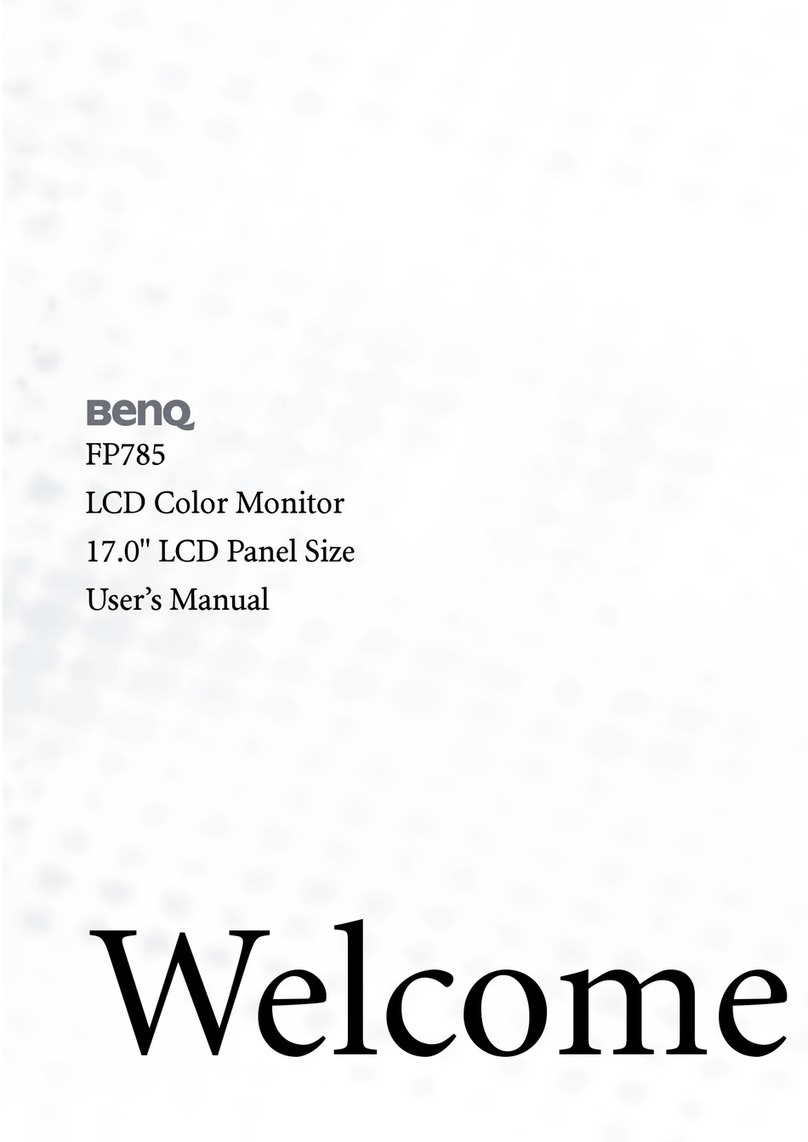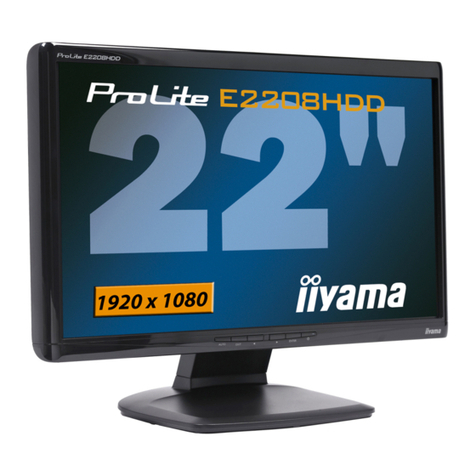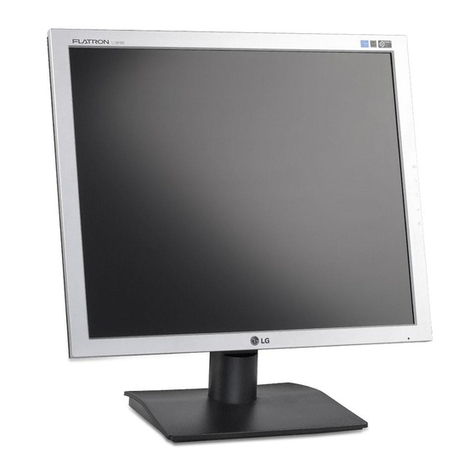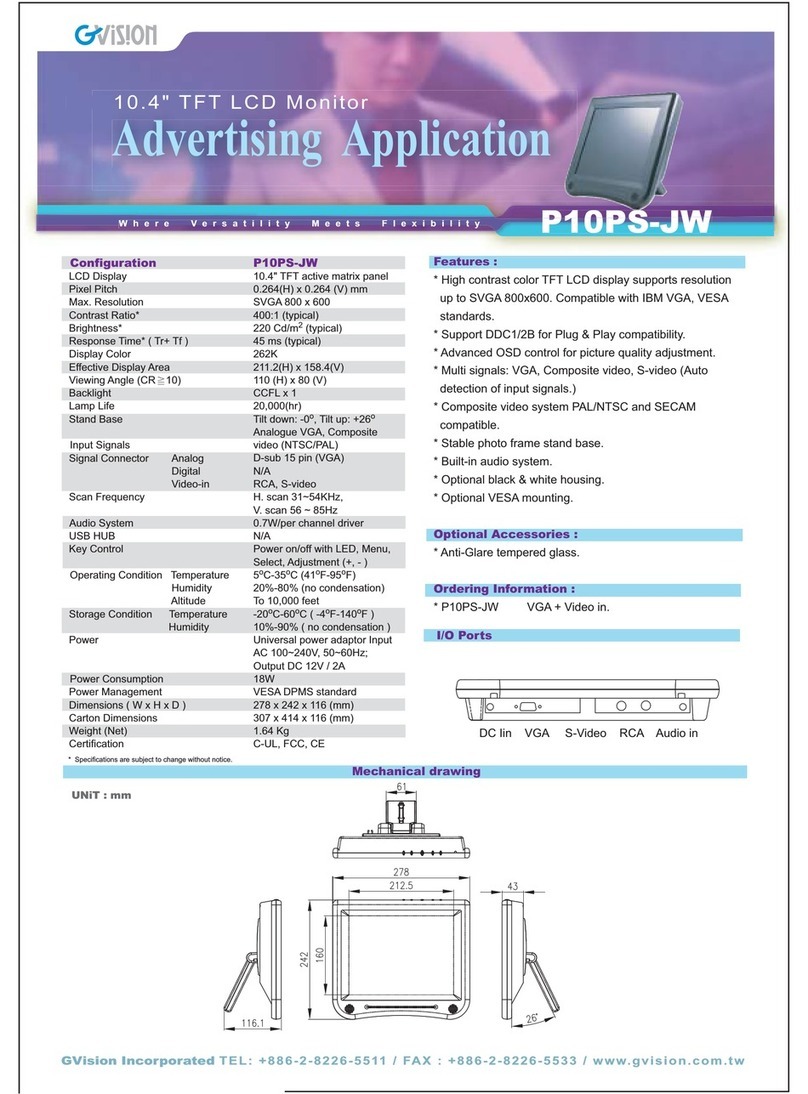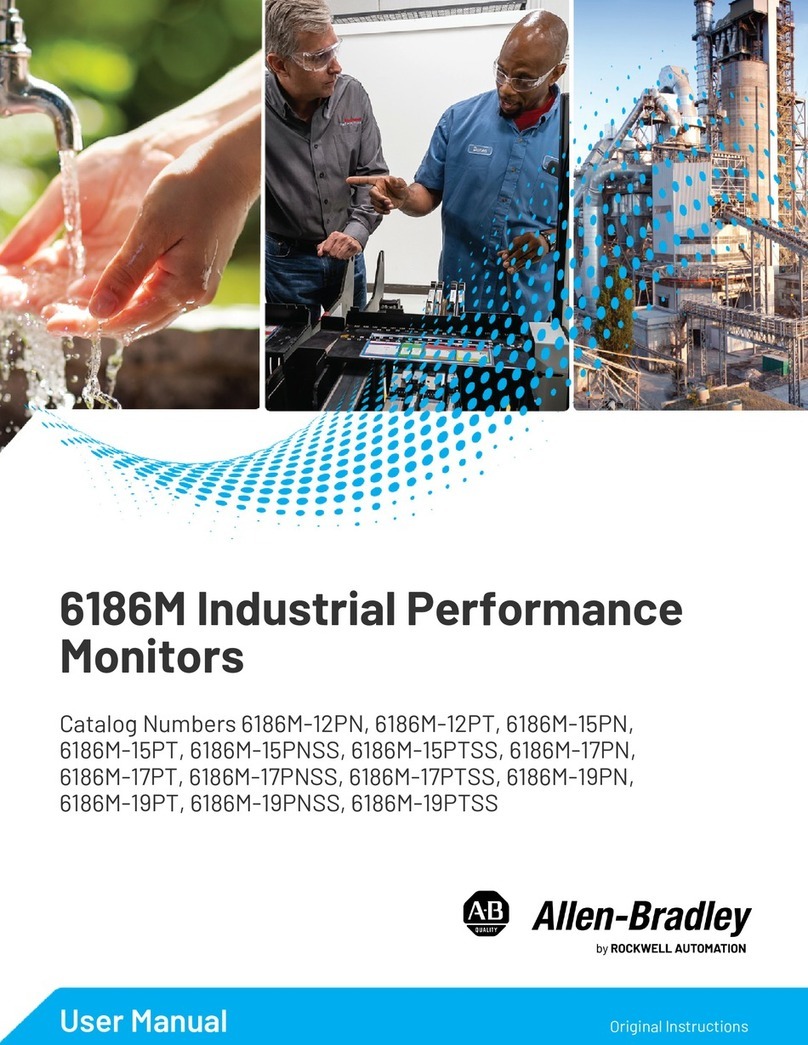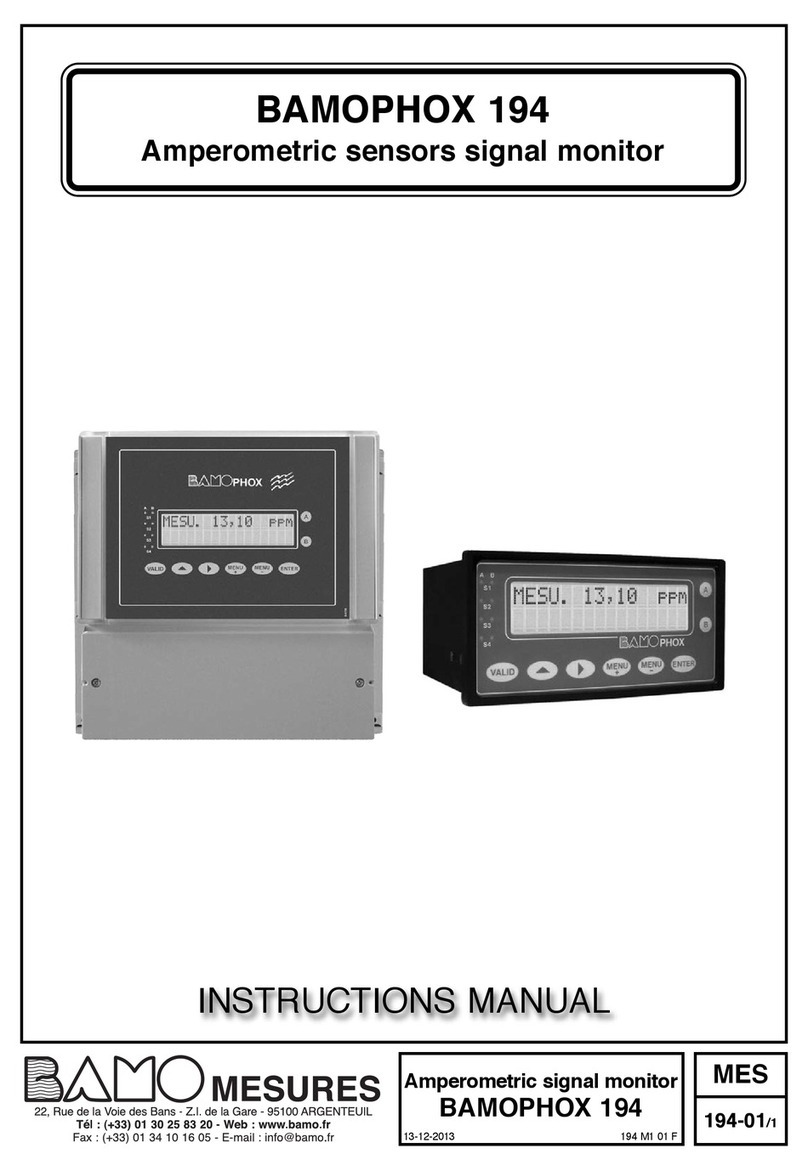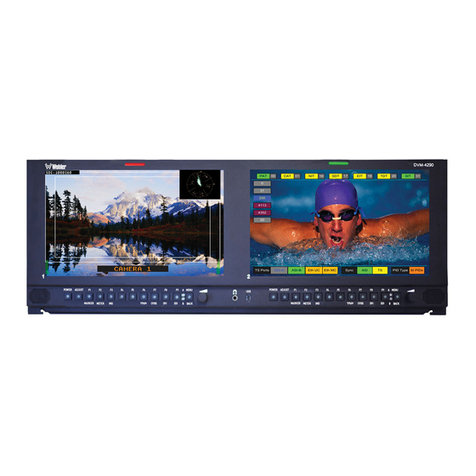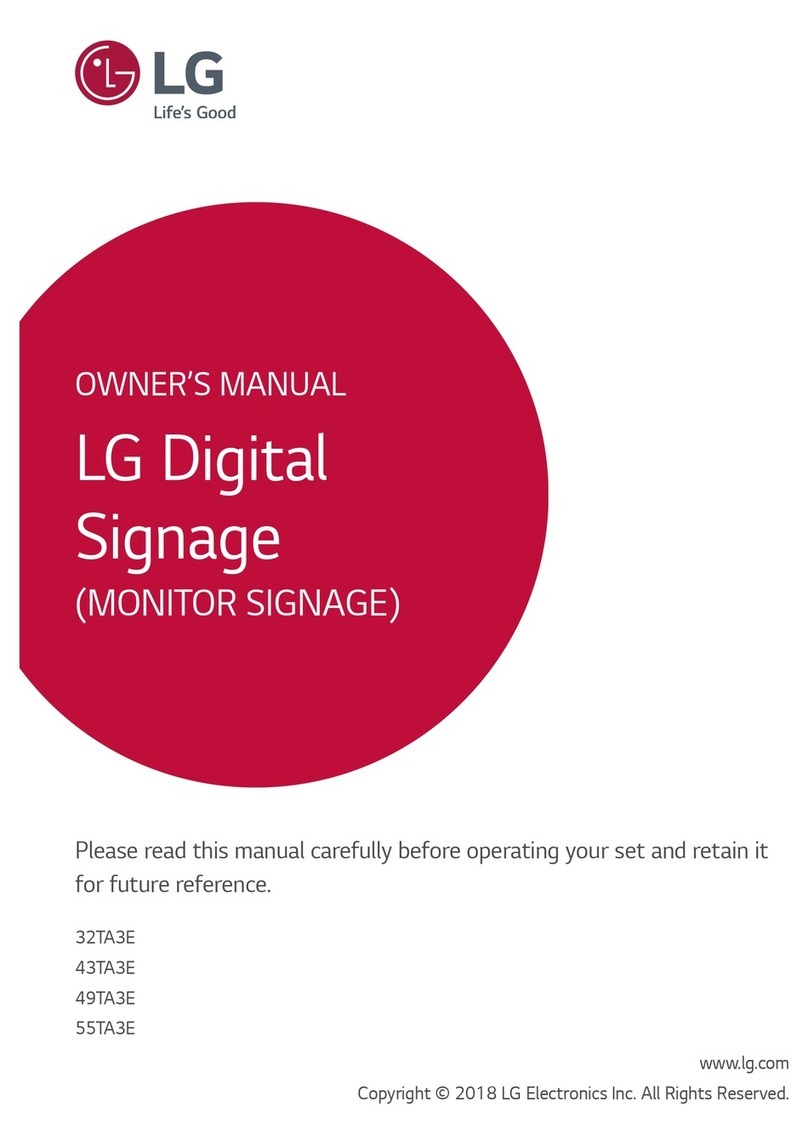Siko AP10T User manual

321/17
AP10T
Set point display with CANopen interface
User manual

AP10T Date: 27.10.2017 Art. No. 88125 Mod. status 321/17 Page 2 of 60
Table of contents
1General Informaton ................................................................................................... 5
1.1 Documentation ........................................................................................................5
2Intended use............................................................................................................. 5
2.1 Switching on the supply voltage.................................................................................5
3Brief description ....................................................................................................... 6
3.1 General ...................................................................................................................6
3.2 LCD display..............................................................................................................6
3.2.1 Extended display range ..........................................................................................6
3.3 LED display..............................................................................................................7
3.4 Keys .......................................................................................................................7
3.5 Communication ........................................................................................................7
3.6 Parameterization of the set point display.....................................................................7
3.6.1 Manual parameterization........................................................................................8
3.6.1.1 Starting parameterization ...................................................................................8
3.6.1.2 Value input.......................................................................................................8
3.6.1.3 Value selection..................................................................................................8
3.6.1.4 Adjustable parameters........................................................................................8
3.6.2 Parameterization via interface ................................................................................9
3.7 Warnings / Errors......................................................................................................9
3.7.1 Warnings .............................................................................................................9
3.7.2 Errors ..................................................................................................................9
3.8 System commands ....................................................................................................9
3.8.1 Restore factory settings .........................................................................................9
3.8.2 Diagnosis...........................................................................................................10
4Communication via CAN bus (CANopen) .................................................................... 10
4.1 Telegram setup.......................................................................................................10
4.2 Node control..........................................................................................................12
4.2.1 Network management services (NMT) .....................................................................12
4.2.1.1 NMT communication statuses ............................................................................13
4.2.1.2 Switching between NMT communication states ....................................................13
4.2.2 Boot-Up.............................................................................................................14
4.2.3 SYNC object........................................................................................................14
4.3 Process data exchange ............................................................................................14
4.3.1 Transfer of Process Data Objects (PDO)...................................................................14
4.3.1.1 Receive-PDO (from Master to AP10T) ..................................................................14
4.3.1.2 Transmit PDO (from AP10T to the master) ...........................................................15
4.3.2 Control word ......................................................................................................16
4.3.3 Status word........................................................................................................16
4.4 Parameter data exchange.........................................................................................17
4.4.1 Transfer of Service data objects (SDO)....................................................................17
4.4.2 Error Response....................................................................................................18

AP10T Date: 27.10.2017 Art. No. 88125 Mod. status 321/17 Page 3 of 60
4.4.3 Examples of SDO access........................................................................................19
4.5 Node monitoring ....................................................................................................20
4.5.1 Emergency Service (EMCY) ....................................................................................20
4.5.2 Node Guarding....................................................................................................21
4.5.3 Heartbeat ..........................................................................................................21
4.5.4 External heartbeat...............................................................................................22
4.5.5 Guarding Bit.......................................................................................................22
4.6 Auto-Functions ......................................................................................................22
4.6.1 Auto-Baud .........................................................................................................22
4.6.2 Auto-ID .............................................................................................................23
4.7 Directory of objects ................................................................................................25
4.7.1 Overview of objects .............................................................................................25
4.7.2 Description of objects..........................................................................................27
4.7.2.1 1000h: Device Type..........................................................................................27
4.7.2.2 1001h: Error Register .......................................................................................27
4.7.2.3 1002h: Manufacturer Status Register ..................................................................28
4.7.2.4 1003h: Pre-defined Error Field...........................................................................28
4.7.2.5 1005h: COB-ID SYNC message............................................................................29
4.7.2.6 1008h: Manufacturer Device Name .....................................................................29
4.7.2.7 1009h: Manufacturer Hardware Version ...............................................................30
4.7.2.8 100Ah: Manufacturer Software Version................................................................30
4.7.2.9 100Ch: Guard Time...........................................................................................30
4.7.2.10 100Dh: Life Time Factor....................................................................................31
4.7.2.11 1010h: Store Parameter....................................................................................31
4.7.2.12 1011h: Restore Parameter.................................................................................33
4.7.2.13 1014h: COB-ID Emergency Message ....................................................................35
4.7.2.14 1017h: Producer Heartbeat Time........................................................................36
4.7.2.15 1018h: Identity Object.....................................................................................36
4.7.2.16 1200h: Server SDO Parameter ............................................................................37
4.7.2.17 1400h: 1. Receive PDO Parameter ......................................................................38
4.7.2.18 1401h: 2. Receive PDO Parameter ......................................................................39
4.7.2.19 1600h: 1. Receive PDO Mapping Parameter..........................................................40
4.7.2.20 1601h: 2. Receive PDO Mapping Parameter..........................................................41
4.7.2.21 1800h: 1. Transmit PDO Parameter .....................................................................42
4.7.2.22 1801h: 2. Transmit PDO Parameter .....................................................................44
4.7.2.23 1A00h: 1. Transmit PDO Mapping Parameter ........................................................45
4.7.2.24 1A01h: 2. Transmit PDO Mapping Parameter ........................................................46
4.7.2.25 2003h: key actuation enable ........................................................................47
4.7.2.26 2004h: key actuation enable ........................................................................47
4.7.2.27 2005h: Configuration enable via keyboard and delay of start of configuration ..........48
4.7.2.28 5000h: Diagnosis of CAN bus errors ....................................................................49
4.7.2.29 5F09h: External Heartbeat timer and external Heartbeat source..............................49
4.7.2.30 5F0Ah: Node-ID, Auto-ID and Baud rate Bus CAN .................................................50

AP10T Date: 27.10.2017 Art. No. 88125 Mod. status 321/17 Page 4 of 60
4.7.2.31 5F0Bh: Display in the 2nd row ............................................................................52
4.7.2.32 5F0Ch: Control word.........................................................................................52
4.7.2.33 5F11h: Decimal places......................................................................................52
4.7.2.34 5F12h: Display orientation and LEDs ..................................................................53
4.7.2.35 5F16h: Read target value..................................................................................55
4.7.2.36 5F19h: Status word..........................................................................................56
4.7.2.37 5F1Bh: Sensor type and operating mode .............................................................57
4.7.2.38 5F1Ch: Acknowledgement settings .....................................................................57
4.7.2.39 6200h: Cycle Timer ..........................................................................................58
4.7.2.40 6503h: Alarms.................................................................................................58
4.7.2.41 6504h: Supported Alarms..................................................................................58
4.7.2.42 6505h: Warnings .............................................................................................59
4.7.2.43 6506h: Supported Warnings ..............................................................................59
4.7.2.44 6507h: Profile and Software Version...................................................................59
4.7.2.45 6508h: Operating Time.....................................................................................60
4.7.2.46 650Bh: Serial Number.......................................................................................60

General Informaton
AP10T Date: 27.10.2017 Art. No. 88125 Mod. status 321/17 Page 5 of 60
1General Informaton
1.1 Documentation
The following documents describe this product:
The data sheet describes the technical data, the dimensions, the pin assignments, the
accessories and the order key.
The installation instructions describe the mechanical and electrical installation including all
safety-relevant requirements and the associated technical specification.
The user manual for commissioning and integrating the set point display into a fieldbus
system.
EDS file (electronic data sheet); this file enables integration and configuration in a CANopen
network by means of commercial CANopen configurators.
These documents can also be downloaded at http://www.siko-global.com/p/ap10t.
2Intended use
The instrument is a set point display. Alpha-numeric set points can be transferred to the
instrument via the CANopen interface and indicated via the backlit two-row LC display.
Receipt of the set points can be acknowledged via the front button. The state of
acknowledgment of the set points is signified by means of the two bi-color LEDs.
Acknowledgment can also be performed via the interface by means of a control word.
Additionally, it can activate the LEDs in order to realize various visualization tasks.
Acknowledgment and button states are output in the status word.
Some device parameters can be adjusted by means of the 3 buttons. You can change the set
point, output the position value and adjust all device parameters via the integrated bus
interface.
2.1 Switching on the supply voltage
The AP10T will be initialized after switching on the supply voltage. A display test is executed
during initialization, the LEDs are lighted consecutively and the configuration parameters are
loaded from the non-volatile memory into the RAM of the controller.
With the display still unconfigured all parameters are set to their default values. See to it that
the bus will be connected only after correct adjustment of baud rate and ID (see chapter 3.6:
Parameterization of the set point display and chapter 4.6: Auto-Functions). The AP10T
functions with the data last parameterized.
After completing the initialization procedure, the AP10T with CAN interface sends a specific
NMT command, the Boot-Up Message, which informs the system about the availability of the
display. The AP10T is now in the Pre-Operational Mode. In this state, the display can be
parameterized via SDO commands in accordance with the requirements of the application. This
applies to configuration parameters as well as to the way it makes available to the system its
position values (asynchronous or synchronous data transmission).

Brief description
AP10T Date: 27.10.2017 Art. No. 88125 Mod. status 321/17 Page 6 of 60
3Brief description
3.1 General
The set point display has a two-line display with special characters and four control keys. The
device is configured and activated via three symbol keys whereas received data is
acknowledged via the fourth key. Two LEDs serve for signifying acknowledgement.
Fig. 1: Control elements
3.2 LCD display
The The display range is limited to -19999 … 99999. Values outside this
range are displayed with "".
With supply voltage applied to the set point display with factory settings, set points are
displayed in both rows depending on validity and acknowledgment status. If there is no valid
set point, "---" will be displayed in the 2nd row. A valid set point flashes until after
acknowledgement.
Two 6-digit set points can be displayed. Both rows are freely writeable.
3.2.1 Extended display range
Values up to -999999 can be displayed by means of the control word. If the relevant bit has
been set and the value to be displayed is between -199999 and -999999, then the negative
sign and the digit of the highest order will flash alternately. If the value range drops below
-99999, "" will be displayed.
LED right
LED left

Brief description
AP10T Date: 27.10.2017 Art. No. 88125 Mod. status 321/17 Page 7 of 60
3.3 LED display
With factory settings, the LED display works according to the following table.
Operating mode
LED
Status
Meaning
There is no valid set
point.
both
off
There is a valid set
point.
LED left
red
Set point1 not acknowledged
green
Set point1 acknowledged
LED right
red
Set point2 not acknowledged
green
Set point2 acknowledged
Table 1: LED display in the Alpha-numeric display operating mode
With the basic function of the LEDs inactivated, every LED can be controlled independently via
the control word (see object 5F12h: Display orientation and LEDs and chapter 4.3.2: Control
word).
3.4 Keys
With the Auto-ID function, the new ID is adopted by actuating the key (see chapter 4.6.2:
Auto-ID).
Pressing the key acknowledges a pending error (see chapter 3.7.2: Errors).
Pressing the key starts the parameterization mode (see chapter 3.6: Parameterization of
the set point display).
When pressing the front button with factory settings active, the previously received set points
(set point1 and set point2) will be acknowledged.
3.5 Communication
Set point1 (in row 1) is received via the receive data object 1 (RPDO1). Likewise, set point2
(in row 2) is received via RPDO2. The data identifier must be correctly set in the respective
control word. The data identifier serves for determining whether the data is interpreted and
displayed as number or as alpha-numeric characters (ASCII) (see chapter 4.3.2: Control word).
Control word: (see chapter 4.3.2)
In the control word, the respective type (number or character string) and the validity of the
set point are transferred to the display. Additionally, the set point can be acknowledged via
the control word.
Status word: (see chapter 4.3.3)
Type, validity and acknowledgement status of the set points are recorded in the status word.
3.6 Parameterization of the set point display
The set point display can be completely parameterized via the bus interface. The most
significant bus parameters (node address and baud rate) can be parameterized manually by
means of the keyboard.

Brief description
AP10T Date: 27.10.2017 Art. No. 88125 Mod. status 321/17 Page 8 of 60
3.6.1 Manual parameterization
3.6.1.1 Starting parameterization
After applying supply voltage and passing initialization, the set point display will be on the
uppermost level of the menu structure (default/factory settings).
By actuating the key, the set node address and baud rate is displayed. Parameterization
starts if this key is actuated during the enable period (see object 2005h: Configuration enable
via keyboard and delay of start of configuration).
3.6.1.2 Value input
Enter values via the key and the key. Confirm values entered by pressing the key.
- decimal place selection key
- value input key
3.6.1.3 Value selection
For some parameters you can select values from a list.
Direct value input is not possible there.
Pressing the key, the value can be selected from the list. By pressing the key, the
selection is confirmed.
3.6.1.4 Adjustable parameters
The following parameters can be adjusted.
Display
Parameter
Options
ID
Node-ID
1 … 127 (see chapter 4.6.2)
KBAUD
Baud rate
Auto baud (see chapter 4.6.1)
125 kbaud
250 kbaud
500 kbaud
800 kbaud
1000 kbaud
CODE
System commands
Load factory settings (see chapter 3.8.1)
Start diagnosis (see chapter 3.8.2)
Table 2: Manually adjustable parameters

Brief description
AP10T Date: 27.10.2017 Art. No. 88125 Mod. status 321/17 Page 9 of 60
3.6.2 Parameterization via interface
The set point display can be completely parameterized in the CANopen interface (see chapter
4: Communication via CAN bus (CANopen)).
3.7 Warnings / Errors
No warnings or errors occur as there is no sensor unit. Communication errors are not displayed
but partly recorded in the error memory (see chapter 3.8.2: Diagnosis).
3.7.1 Warnings
No warnings are output.
3.7.2 Errors
No errors are displayed.
3.8 System commands
3.8.1 Restore factory settings
For restoring the factory settings of the device, the following options are available:
Access
Coding
Factory settings are restored
Manuell
011100
all parameters
011102
all, except bus parameters
011105
only bus parameters
CANopen
(see object
1011h: Restore
Parameter)
1011h
"load"
Subindex 1
all parameters
Subindex 2
only bus parameters
Subindex 3
only Draft Standard-406 parameters
Subindex 4
only manufacturer-specific parameters
Table 3: Access to factory settings
The bus parameters are:
Display
Parameter address
Parameter
ID
5F0Ah
Node-ID
KBAUD
5F0Ah
Baud rate
-
1005h
COB-ID SYNC
-
100Ch
Guard Time
-
100Dh
Life Time Factor
-
1014h
COB-ID Emergency
-
1017h
Heartbeat timer value

Communication via CAN bus (CANopen)
AP10T Date: 27.10.2017 Art. No. 88125 Mod. status 321/17 Page 10 of 60
Display
Parameter address
Parameter
-
1400h Subindex1
COB-ID RPDO1
-
1400h Subindex2
Transmission Type RPDO1
-
1401h Subindex1
COB-ID RPDO2
-
1401h Subindex2
Transmission Type RPDO2
-
1800h Subindex1
COB-ID TPDO1
-
1800h Subindex2
Transmission Type TPDO1
-
1800h Subindex5
Event Timer TPDO1
-
1801h Subindex1
COB-ID TPDO2
-
1801h Subindex2
Transmission Type TPDO2
-
5F09h Subindex1
Ext. Heartbeat value
-
5F09h Subindex2
Ext. Heartbeat source
-
1001h
Error Register
Table 4: Bus parameters
3.8.2 Diagnosis
In order to receive a list of all device errors occurring in connection with chapter 3.7 it is
necessary to switch the device to the diagnosis mode. For this purpose, enter CODE
"200000"in parameterization (see chapter 3.6.1: Manual parameterization) and confirm by
pressing the key. Any errors occurring are output indicating the error number and total of
occurrences in the upper row. The type of error is shown in the lower row. Error number 1
contains the latest error. The oldest error is output with the highest error number.
4Communication via CAN bus (CANopen)
The CiA DS-301 V4.2 CANopen communication profile as well as the Device profile for Encoders
CiA DS-406 V3.2 form the basis for AP10T, which supports device class C2. As this device is
beyond the scope of an encoder's functionality, communication partly differs from the above-
mentioned device profile. This document contains the details necessary for understanding the
operation of the device. If more-in-depth information is required we recommend to consult
the pertinent specialized literature on CAN or CANopen.
4.1 Telegram setup
The data telegram of a CAN message consists of the following fields:
SOF
Identifier (COB-ID)
Control field
Data field (max. 8 byte)
CRC
ACK / EOF
SOF:
(Start of Frame) start bit of the telegram

Communication via CAN bus (CANopen)
AP10T Date: 27.10.2017 Art. No. 88125 Mod. status 321/17 Page 11 of 60
Identifier (COB-ID):
All bus sharing units check via identifier whether the message is relevant for them.
The identifier sets the priority of the message. The lower the value of the identifier, the
higher the priority of the message. This results in preferential transfer of messages via the
bus.
The Identifier field contains the identifier as well as bits for the recognition of the length of
the identifierss (11 or 29 bit). Furthermore, the identifier serves for determining the device
address, the channel selection as well as the direction of data transfer.
The 11bit identifier (COB identifier) consists of a 4bit function code and a 7bit node number:
Bit no.
10
9
8
7
6
5
4
3
2
1
0
Type
Function code
Node number (node ID)
Assignment
x
x
x
x
0
0
x
x
x
x
x
The following function codes have been defined in the "Pre-defined Connection Set" (only the
function codes used in the present device are listed):
Object
Function code
Resulting COB-ID
Object
Page
Network management (NMT)
0000b
0
-
-
SYNC message
0001b
128 (80h)
1005h
29
Emergency message
0001b
128 (80h) + Node-ID
1014h
35
TPD01
0011b
384 (180h) + Node-ID
1800h
42
RPD01
0100b
512 (200h) + Node-ID
1400h
38
TPD02
0101b
640 (280h) + Node-ID
1801h
44
RPD02
0110b
768 (300h) + Node-ID
1401h
39
SDO (tx)
1011b
1408 (580h) + Node-ID
1200h
37
SDO (rx)
1100b
1536 (600h) + Node-ID
1200h
37
Heartbeat message
1110b
1792 (700h) + Node-ID
-
-
Node Guard message
1110b
1792 (700h) + Node-ID
-
-
Table 5: Overview of COB identifiers
Changes to COB-IDs are only possible in the PRE-OPERATIONAL NMT status. First, the COB-ID
must be deactivated via Bit 31 = 1b before it can be changed and reactivated.
The COB-ID of the SYNC object is an exception. There, Bit 30 must be = 0 to enable the
change of the COB-ID. The COB-ID could be changed any time because Bit 30 cannot be set to
1 in the AP10T device.
The identifier determines the priority of the message. The lower the value of the identifier,
the higher the priority of the message.
The node number (Node-ID) (see object 5F0Ah: Node-ID, Auto-ID and Baud rate Bus CAN) is
assigned in every bus system once while AP10T is being configured. Node-ID = 0 is reserved
and must not be used; thus the node numbers are in the range of 1 to 127.
A newly set node number will only be adopted with reinitialization (see chapter 4.2: Node
control).
The set point display is delivered with the factory-set Node-ID 125 (7Dh).

Communication via CAN bus (CANopen)
AP10T Date: 27.10.2017 Art. No. 88125 Mod. status 321/17 Page 12 of 60
Control field:
Contains bit-by-bit information on the number of user data and decides whether a data frame
or a Remote Transmission Request (RTR) frame is concerned.
Data field:
Contains up to 8 bytes of user data. The user data has a different meaning depending on the
channel selection.
CRC:
Contains bits for error detection.
ACK/EOF:
The ACK/EOF field contains telegram acknowledgement bits as well as bits for determining the
end of telegram.
For a detailed description of the telegram refer to the relevant CAN expert literature. For
simplification, only identifier (COB-ID) and data field will be dealt with in the subsequent
telegram descriptions.
4.2 Node control
4.2.1 Network management services (NMT)
The master configures, manages and monitors network nodes via the NMT service. The device
is always in one of the four communication statuses "INITIALISATION", "PRE-OPERATIONAL",
"OPERATIONAL" or "STOPPED" (see Fig. 2).
Fig. 2: NMT status diagram
Power on or software reset
Initialization
CAN-communication
BootUp Message
1
2
2
3
3
4
4
4
1
Re-initialization
CAN-card
5
5
5
Init

Communication via CAN bus (CANopen)
AP10T Date: 27.10.2017 Art. No. 88125 Mod. status 321/17 Page 13 of 60
4.2.1.1 NMT communication statuses
NMT Status INITIALIZATION
The unit is not involved in the bus actions in this state. All hardware and software
components are initialised. This state is attained after switching on the device or after receipt
of the command code 81h of the own or global addresses. After receiving the command code
82h, the display is also in the initialization status. However, only the hardware and software
associated with CAN communication is reinitialized. The device automatically signifies
completion of initialization via a boot-up message. After successful transmission of the boot-
up message, the device will be in the "PRE-OPERATIONAL" status.
NMT Status PRE-OPERATIONAL
Parameterization data (SDO) can be exchanged in the Pre-Operational Mode. However, no
process data (PDO) is transferred.
NMT Status OPERATIONAL
Exchange of process data is enabled as well.
NMT Status STOPPED
Communication is stopped except for Heartbeat and Node Guarding. Only NMT communication
is enabled.
4.2.1.2 Switching between NMT communication states
Telegrams with the following structures are used for switching between the communications
statuses:
Status change
Transition
in Fig. 2
COB-ID
Com.
Node-
ID
from
to
PRE-OPERATIONAL / STOPPED
OPERATIONAL
1
0h
01h
x
OPERATIONAL/ PRE-OPERATIONAL
STOPPED
2
0h
02h
x
OPERATIONAL / STOPPED
PRE-OPERATIONAL
3
0h
80h
x
OPERATIONAL / PRE-OPERATIONAL /
STOPPED
INITIALISATION
(Reset Node)
5
0h
81h
x
OPERATIONAL / PRE-OPERATIONAL /
STOPPED
INITIALISATION
(Reset Communication)
4
0h
82h
x
Table 6: Switching between communication statuses
If transmitted as Node-ID x = 0, the message is intended for all bus subscribers.

Communication via CAN bus (CANopen)
AP10T Date: 27.10.2017 Art. No. 88125 Mod. status 321/17 Page 14 of 60
4.2.2 Boot-Up
The COB-ID of the Boot-Up message consists of 700h and the Node-ID. The NMT-status
"Initialization" is output as data content.
COB-ID
Byte 0
700h + Node-ID
00h
Table 7: Boot-Up message
4.2.3 SYNC object
CANopen makes it possible to simultaneously scan inputs and simultaneously set outputs. This
is accomplished by the synchronization message (SYNC), a high-priority CAN message. The
identifier of the Sync object can be set via object 1005h (see 1005h: COB-ID SYNC message).
4.3 Process data exchange
4.3.1 Transfer of Process Data Objects (PDO)
Process data objects (PDO) serve for quick process data exchange. A maximum of 8 bytes of
user data can be transferred in a PDO. AP10T supports the Receive-PDO services RPDO1 and
RPDO2 according to Draft Standard 301 as well as the Transmit-PDO services TPDO1 and TPDO2
according to Draft Standard 301 and Device Profile 406.
4.3.1.1 Receive-PDO (from Master to AP10T)
Using Receive-PDO transfer (RPDO), set points and control commands (see chapter 4.3.2:
Control word) can be transmitted from the bus master to the display.
COB-ID
Process data in binary code
Byte 0
(LSB)
Byte 1
Byte 2
Byte 3
(MSB)
Byte 4
Byte 5
Byte 6
Byte 7
RPDO1
200h + Node-ID
Target value 1 (indicated in the
upper row)
Data identifier
equal to ASCII:
Byte 4 and 5 of
set point 1
5F0Ch: Control
word (see
chapter 4.3.2)
Otherwise dummy
0x0000
RPDO2
300h + Node-ID
Target value 2 (indicated in the
lower row)
Data identifier
equal to ASCII:
Byte 4 and 5 of
set point 2
Otherwise dummy
0x0000
Table 8: RPDO message

Communication via CAN bus (CANopen)
AP10T Date: 27.10.2017 Art. No. 88125 Mod. status 321/17 Page 15 of 60
The transfer behavior of RPDO1 is defined via objects 1400h and 1600h. RPDO2 is defined via
objects 1401h and 1601h. A differentiation is made between Set point1 und Set point2. Set
point1 is displayed in the upper row and Set point2 in the lower row.
4.3.1.2 Transmit PDO (from AP10T to the master)
PDO transfer from the display to the bus master (TPDO) can be initiated as a result of various
events:
asynchronous, controlled by an internal device timer
synchronous as a reply to a SYNC message
as a reply to an RTR message
TPDO1 and TPDO2 are always formed from a status word (see chapter 4.3.3: Status word) and
the current set points. Set point1 is delivered via TPDO1, Set point2 via TPDO2.
The transfer behavior of TPDO1 is determined via objects 1800h, 1A00h and 6200h and is
assigned to asynchronous transfer. TPDO2 is defined via objects 1801h and 1A01h and serves
for synchronous transfer.
The messages have the structure shown in Table 9, and mapping cannot be changed.
COB-ID
Process data in binary code
Byte 0
(LSB)
Byte 1
Byte 2
Byte 3
Byte 4
Byte 5
(MSB)
Byte 6
Byte 7
TPDO1
180h + Node-ID
Target value 1 (displayed in the upper row)
5F19h: Status
word (see
chapter 4.3.3)
TPDO2
280h + Node-ID
Target value 2 (displayed in the lower row)
Table 9: TPDO message
Asynchronous data transfer (TPDO1)
If a TPDO1 is to be sent cyclically, then the cycle time must be entered into object 1800h,
sub-index 5, in milliseconds. The TPDO1 will not be sent if the value 0 ms is written. The
function is disabled. The minimum value to be set is 1 (=1 ms) Alternately, the value can also
be written into the object 6200h which is permanently linked internally.
Synchronous data transfer (TPDO2)
The device is factory set to reply by output of the TPD02 message when receiving a SYNC
message. Thus it is set to the synchronous transfer type. 1 is entered in object 1801h, sub-
index 2. The device responds to every n SYNC message if a value n between 1 and 240 (=F0h)
has been entered.
RTR
Queries can be sent to TPD01 and TPD02 via RTR (see chapter 4.1: Telegram setup, Control
field).

Communication via CAN bus (CANopen)
AP10T Date: 27.10.2017 Art. No. 88125 Mod. status 321/17 Page 16 of 60
4.3.2 Control word
The control word consists of 16 bits and is mapped in the object 5F0Ch: Control word. This
object is received with both Receive PDOs.
Control word
15
14
13
12
11
10
9
8
7
6
5
4
3
2
1
0
MSB High Byte
Low Byte LSB
The following table lists the designations of the individual bits of the control word and their
meanings.
Bit
Meaning
Value = 0
Value = 1
0
reserved
ever 0
-
1
reserved
ever 0
-
2
validity of Set point1
invalid
valid
3
display range
standard
extended
4
reserved
ever 0
-
5
reserved
ever 0
-
6
acknowledgement of Set point2
not acknowledged
acknowledged
7
data identifier
number
ASCII
8
Guarding Bit
is taken over
is taken over
9
validity of Set point2
invalid
valid
10
acknowledgement of Set point1
not acknowledged
acknowledged
11
LED1 green left
Off
On
12
LED3 green right
Off
On
13
LED4 red right
Off
On
14
LED2 red left
Off
On
15
LED blinking
Off
On
Table 10: Control word
4.3.3 Status word
The status word indicates the current status of AP10T. It consists of 16 bits and is mapped in
the object 5F19h: Status word as well as in the two Transmit-PDOs.
Status word
15
14
13
12
11
10
9
8
7
6
5
4
3
2
1
0
MSB High Byte
Low Byte LSB
The following table lists the designations of the individual bits of the status word and their
meanings.
Bit
Meaning
Value = 0
Value = 1
0
front key
not actuated
actuated
1
reserved
ever 0
-
2
validity of Set point1
invalid
valid
3
acknowledgement of Set point2
not acknowledged
acknowledged

Communication via CAN bus (CANopen)
AP10T Date: 27.10.2017 Art. No. 88125 Mod. status 321/17 Page 17 of 60
Bit
Meaning
Value = 0
Value = 1
4
reserved
ever 0
-
5
acknowledgement of Set point1
not acknowledged
acknowledged
6
reserved
ever 0
-
7
reserved
ever 0
-
8
Guarding Bit
is output
is output
9
data identifier
number
ASCII-String
10
validity of Set point2
invalid
valid
11
reserved
ever 0
-
12
reserved
ever 0
-
13
key
not actuated
actuated
14
key
not actuated
actuated
15
key
not actuated
actuated
Table 11: Status word
4.4 Parameter data exchange
4.4.1 Transfer of Service data objects (SDO)
Service data objects serve mainly for device configuration via the directory of objects.
SDOs are exchanged between two participants exclusively via expedited Request/Response.
User data is sent already with the initialization message. The identifier is set to 11 bits and
cannot be changed.
Two SDO services are available:
SDO (rx) (master AP10T): 600h + Node-ID
SDO (tx) (AP10T master): 580h + Node-ID
These SDO identifiers cannot be changed!
SDO messages are set up as follows:
COB-ID
User data in binary code
Byte 0
read / write
Byte 1
LSB
Byte 2
MSB
Byte 3
Byte 4
LSB
Byte 5
Byte 6
Byte 7
MSB
SDO rx/tx
+ Node-ID
command
index
sub-
index
service data (parameters)
Command byte, Byte 0:
The command byte determines the type of access and the number of valid data bytes. The
following command bytes are valid for AP10T:
Command byte
Type
Function
Write Request
23h
SDO (rx), Initiate Download
Request, expedited
Send parameter to AP10T
(all 4 data bytes valid)

Communication via CAN bus (CANopen)
AP10T Date: 27.10.2017 Art. No. 88125 Mod. status 321/17 Page 18 of 60
Command byte
Type
Function
Write Request
2Bh
SDO (rx), Initiate Download
Request, expedited
Send parameter to AP10T
(2 bytes from 4 data bytes valid)
Write Request
2Fh
SDO (rx), Initiate Download
Request, expedited
Send parameter to AP10T
(1 byte from 4 data bytes valid)
Write Response
60h
SDO (tx), Initiate Download
Response
Acknowledgement of data
acquisition to master
Read Request
40h
SDO (rx), Initiate Upload
Request
Request parameter from AP10T
Read Response
43h
SDO (tx), Initiate Upload
Response, expedited
Report parameter to master
(all four data bytes are valid)
Read Response
4Bh
SDO (tx), Initiate Upload
Response, expedited
Report parameter to master
(2 bytes from 4 data bytes valid)
Read Response
4Fh
SDO (tx), Initiate Upload
Response, expedited
Report parameter to master
(1 byte from 4 data bytes valid)
Error Response
80h
SDO (tx), Abort Domain
Transfer
AP10T reports error code to master
Table 12: Command coding
Index, bytes 1 and 2:
The index (object number) is entered in user data byte 2 (low byte) and in in user data byte 3
(high byte) in the Intel data format. Here, the index of the object to be parameterized is
entered.
Sub-index, byte 3:
The sub-index indicates the number of the fields for objects realized as an array.
Service data (Parameter), byte 4-7:
In the service data area, the value of the parameter is entered in left-aligned Intel notation.
Byte 4 = low-Byte ... Byte 7 = high Byte.
4.4.2 Error Response
An error report (Abort) is returned to the master in case of invalid access.
The error codes are described in the CANopen profile (DS 301) or in the encoder profile (DSP
406), respectively. The following table shows the error codes used:
Error code
Description
06010000h
Wrong access to an object.
06010001h
Read access to Write-Only.
06010002h
Write access to Read-Only.
06020000h
Object doesn't exist in the object directory.
06090011h
Sub-index does not exist.
06090030h
Wrong value range of selected parameter.
08000020h
Parameters cannot be transferred to application or stored.

Communication via CAN bus (CANopen)
AP10T Date: 27.10.2017 Art. No. 88125 Mod. status 321/17 Page 19 of 60
Error code
Description
08000022h
Parameters cannot be transferred to application or stored due to the
current device status.
08000024h
no data available
Table 13: Error code
4.4.3 Examples of SDO access
Example of reading SDO parameters:
Read the number of decimal places stored in object 5F11h of the objects directory from the
AP10T with device address 1.
Calculation of the identifier: 600h + Node-ID = 600h +1h = 601h
Command: 40h
Index: 5F11h
Sub-index: 00h
The current value is 2 = 02h
Request by the master from the slave with Node ID 1:
COB-ID
User data
Command
Index L
Index H
Sub-index
Data 0
Data 1
Data 2
Data 3
601h
40h
03h
60h
00h
x
x
x
x
Response to the request by the slave:
Calculation of the identifier: 580h + Node-ID = 581h
COB-ID
User data
Command
Index LB
Index HB
Sub-index
Data 0
Data 1
Data 2
Data 3
581h
4Fh
(1 byte
valid)
11h
5Fh
00h
02h
x
x
X
Example of writing SDO parameters:
Change the display orientation stored with 1 byte in object 5F12h, sub-index 1 of the objects
directory in the AP10T with device address 1.
Calculation of the identifier: 600h + Node-ID = 600h + 1 = 601h
Command: Write 1 byte: 2Fh
Index: 5F12h
Sub-index: 01h
The new value shall be 1 = 01h (corresponds to orientation = 180°).

Communication via CAN bus (CANopen)
AP10T Date: 27.10.2017 Art. No. 88125 Mod. status 321/17 Page 20 of 60
Write a value from master to slave with Node ID 1:
COB-ID
User data
Command
Index L
Index H
Sub-index
Data 0
Data 1
Data 2
Data 3
601h
2Fh
(1 byte
valid)
12h
5Fh
01h
01h
00h
00h
00h
Response of the slave to the command:
Calculation of the identifier: 580h + Node-ID = 580h + 1 = 581h
COB-ID
User data
Command
Index L
Index H
Sub-index
Data 0
Data 1
Data 2
Data 3
581h
60h
14h
5Fh
00h
00h
00h
00h
00h
4.5 Node monitoring
4.5.1 Emergency Service (EMCY)
The status of the bus subscriber is transferred via high-priority emergency messages in case of
error. These messages have a data length of 8 bytes and contain information on the error.
The emergency message is transferred as soon as a serious communication error occurred or
was corrected. The cause of error is stored in the error buffer (see object 1003h: Pre-defined
Error Field). An emergency object is sent only once per error event. Removal of a cause of
error is signified by sending an emergency message with Error Code 0000h (No Error). If
multiple errors exist and one cause of an error has been corrected, then Error Code 0000h is
output as well; however, the persisting error condition is indicated in the Error Register.
Identifier
Byte 0
Byte 1
Byte 2
Byte 3
Byte 4
Byte 5
Byte 6
Byte 7
11/ 29 Bit
Emergency Error
Code
Error Register
(Object 1001h)
Manufacturer-specific error field
(not used)
Emergency Error Code:
Error description
Error Code
Cause of error removed
0x0000
Bus Status changed over to the Error Passive Mode
0x8120
Recovered from Bus Off
0x8140
Table 14: Emergency Error Code
The identifier of the emergency object is set to 80h + Node-ID by default; however, it can be
changed via object 1014 h (see 1014h: COB-ID Emergency Message). Transmission of an
emergency message is only possible in the "OPERATIONAL" or "PRE-OPERATIONAL" NMT
statuses.
Other manuals for AP10T
1
Table of contents
Other Siko Monitor manuals

Siko
Siko MA508 User manual
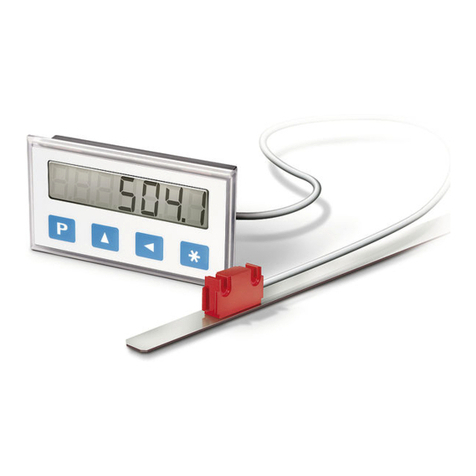
Siko
Siko MA504/1 Software S User manual
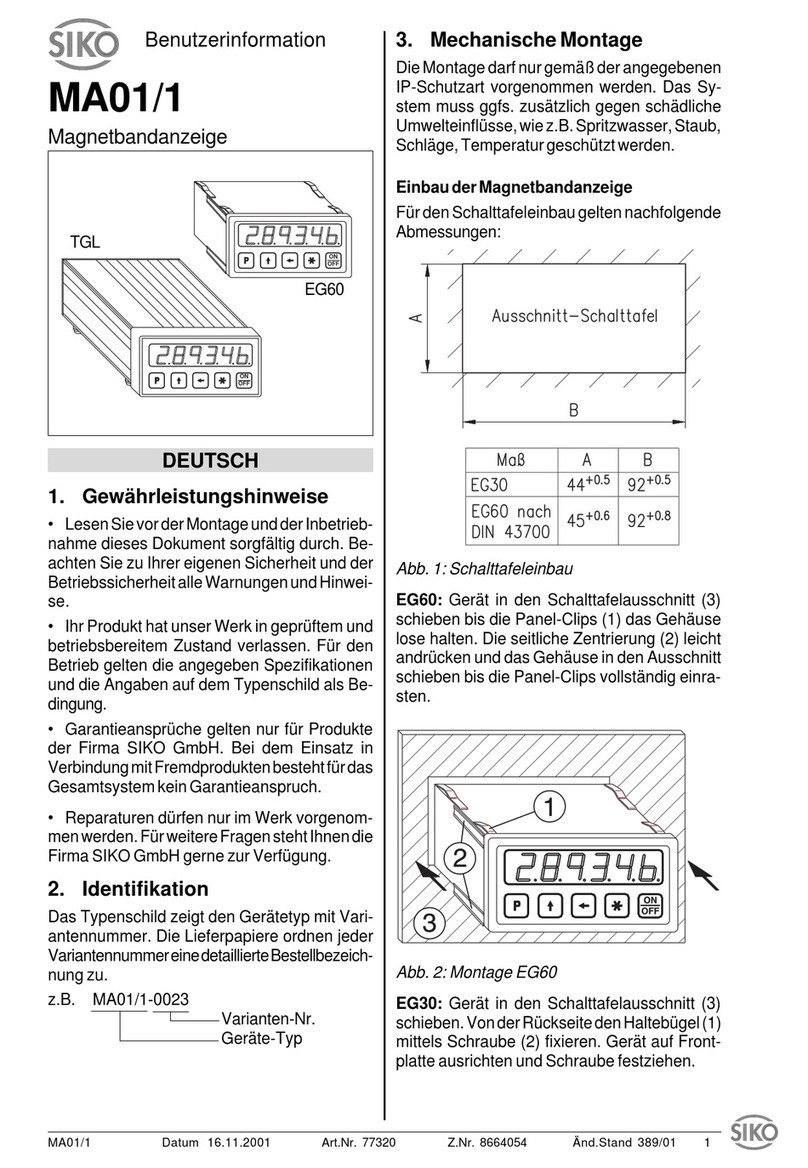
Siko
Siko MA01/1 Operation manual
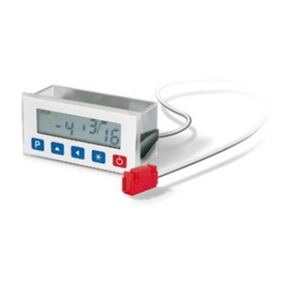
Siko
Siko MA503/1 User manual

Siko
Siko MA523/1 User manual
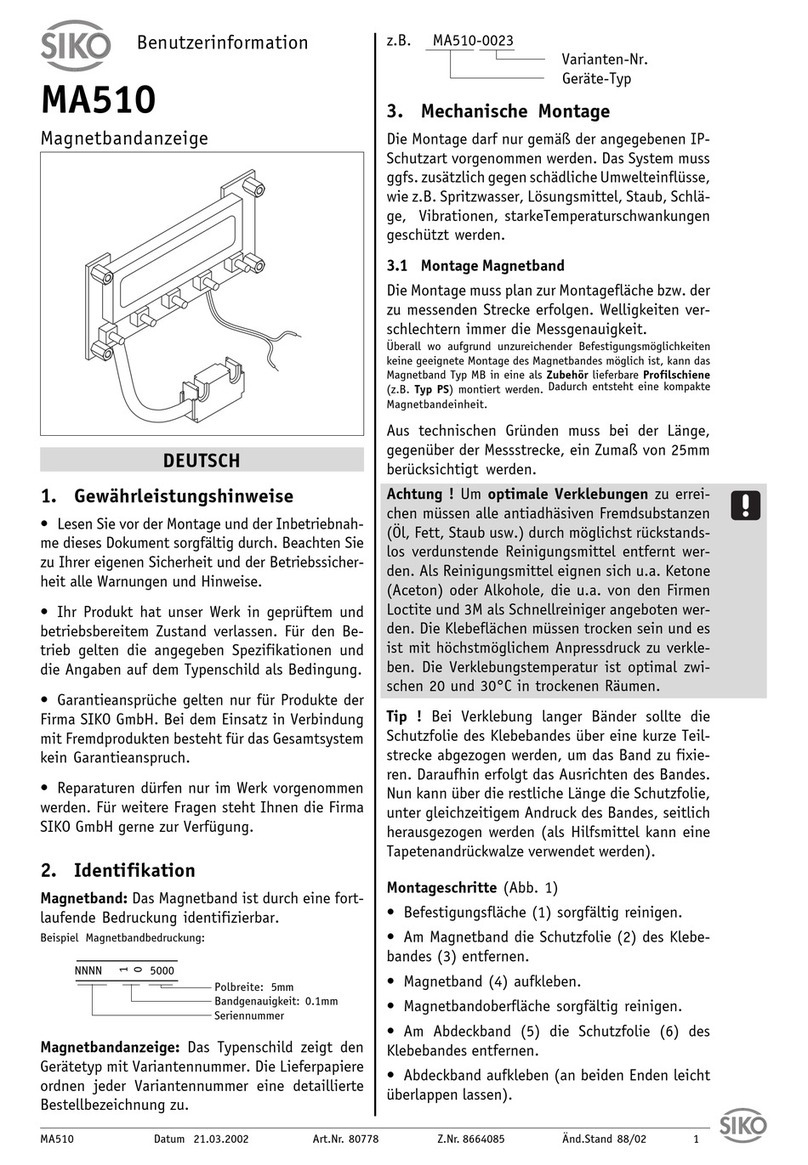
Siko
Siko MA510 Operation manual
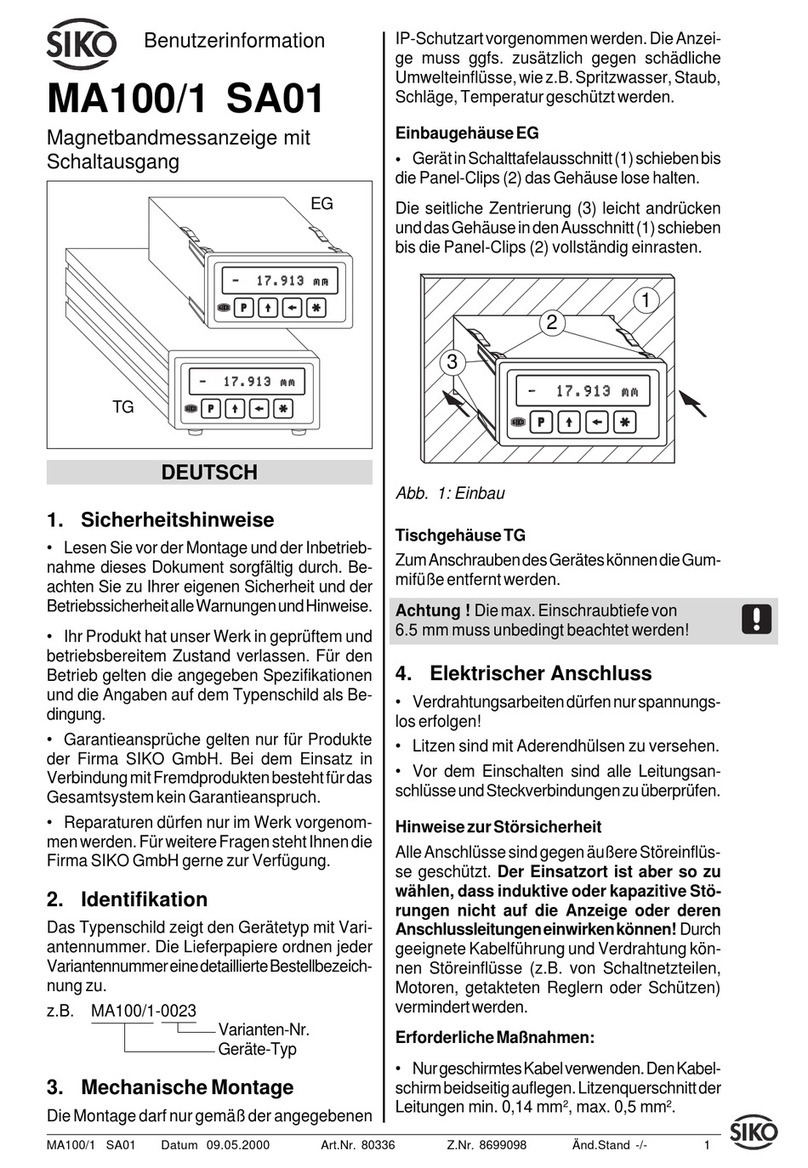
Siko
Siko MA100/1 SA01 Operation manual

Siko
Siko MA561 Operation manual

Siko
Siko MA02/1 User manual

Siko
Siko MA48 User manual
